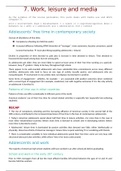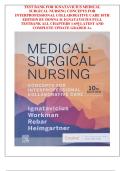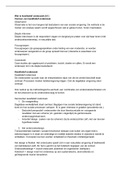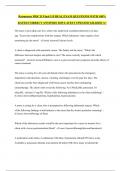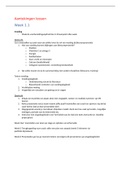As the syllabus of the course postulates, this parts deals with media use and Work
(Chapter 7).
envt = environment; dvpt = development; = = is/are; cc = cognitive/cognition; btwn =
between; w/ = with; a = adolescent; ace = adolescence; ctxt = context
Adolescents’ free time in contemporary society
Sources of abundance of free time:
Compulsory schooling (no full-time work)
Increased affluence following WWII (invention of “teenager”, more autonomy, became consumers, spend
income themselves most advertising targeting adolescents = leisure)
Decline in proportion of time devoted to paid jobs & increase in time devoted to leisure. Time devoted to
housework decreased among boys but not among girls.
As adolescents get older, they are more likely to spend at least some of their free time working at a paid job.
However, busy 9th-graders = likely to be busy throughout high school.
There appear to be well-rounded adolescents who have substantial time commitments across many different
activities, adolescents who tend to focus on one type of activity (usually sports), and adolescents who are
nonparticipants involvement in one activity does not displace involvement in another.
Some forms of engagement— athletics, for example — are associated with positive outcomes when combined
with a second type of engagement (for example, academics), but with negative outcomes if it is the only activity
an adolescent is involved in.
Patterns of time use in other countries
Patterns of time use differ considerably in different parts of the world.
American students’ use of their free time for school-related activities is especially low (especially low-achieving
students).
RECAP
• The rise of compulsory schooling and the increasing affluence of American society in the second half of the
20th century contributed to the increased importance of free time in the lives of contemporary adolescents.
• Today’s American adolescents spend about half their time in leisure activities—far more than is the case in
most other industrialized countries (where more time is devoted to school) and in developing nations (where
more time is devoted to work).
• Adolescents’ leisure time is dominated by passive activities that demand very little, either intellectually or
physically. About two-thirds of American teenagers’ leisure time is spent watching TV or socializing with friends.
• There is considerable variability in how individual adolescents spend their free time; some are very busy with
structured extracurricular activities, while others’ time is far more unstructured.
Adolescents and work
The majority of American high school students will have worked in an after-school job before graduating.
School and work in the early 20th century
Prior to 1925, teenagers from all but the most affluent families left school between the ages of 12 and 15 and
became full-time workers.
, As secondary education became more widespread among different socioeconomic segments of American society,
more youngsters remained in school well into middle and late adolescence, and fewer elected to work.
Compulsory education laws were passed in most states that required individuals to remain in school until at least
turning 16, part-time jobs were not plentiful, and a variety of child labour laws were enacted to restrict
adolescents’ employment.
The rate of adolescent workers decreased a lot until 1940.
The rise and fall of the student worker
Later, employers needed workers who were willing to work part-time for relatively low wages and for short work
shifts.
The proportion of American high school students holding part-time jobs rose dramatically during the 1970s and
working during the school year became a way of life.
This trend began to reverse itself about 15 years ago, for several reasons (tougher standards in high schools
demands on students out of school; retraction of the economy during the first decade of the 21 th century
increased competition for jobs; new technologies as preferred to spend after-school hours on that kind of
leisure).
Teenage employment in other nations
In developing nations where industrialization is still in a relatively early stage and a large percentage of the
population is poor, adolescents generally leave school early (work obligations take precedence over schooling:
support families from 15-16 years old).
The trade-off between school and work is changing in the developing world, however. As more and more
adolescents from developing nations have stayed in school, the number of adolescents in these countries’ labour
force has declined at about the same rate.
Other comparably industrialised countries varies considerably from country to country. Depends on school
schedules (Europe: school until late in the afternoon). in most other industrialized countries, the employment of
children is still associated with being poor, and there is a strong stigma attached to having one’s children work.
Many middle-class parents do not feel that it is appropriate for their children to have jobs while attending school.
The adolescent workplace today
Common adolescent jobs
The vast majority of teenagers are employed in the retail and service industries. In general, older students are
more likely to hold formal jobs (for example, retail or restaurant work) than are younger students, who are more
likely to hold informal jobs (such as babysitting or yard work).
A small number of jobs accounts for a very large proportion of today’s student workers.
The adolescent work environment
Most teenagers’ jobs are fairly dreary. Few jobs permit adolescents to behave independently or make decisions;
they receive little instruction from their supervisors, and they are rarely required to use the skills they have been
taught in school.
Some jobs: a lot of stress, may be dangerous (injuries), time pressure.
Adolescents in better jobs—jobs in which they can learn genuinely useful skills, for example—benefit from
employment. While this may be true in theory, the fact is that the proportion of adolescents who hold jobs in
which there is ample opportunity to learn new or higher-level skills is quite small.
The majority of adolescent workers describe their jobs in favourable terms, saying that they learned things, liked
the people with whom they worked, had opportunities to exercise responsibility, and were satisfied with their
pay.
How can we explain this difference between adults’ conceptions of adolescents’ work environments and
teenagers’ own descriptions of their experiences? compared to school (as are frequently bored & seldom
challenged, even the jobs that adults consider menial are comparatively satisfying to teenagers. + having money,
responsibility make them feel better about themselves positive description of their work xpce.)


